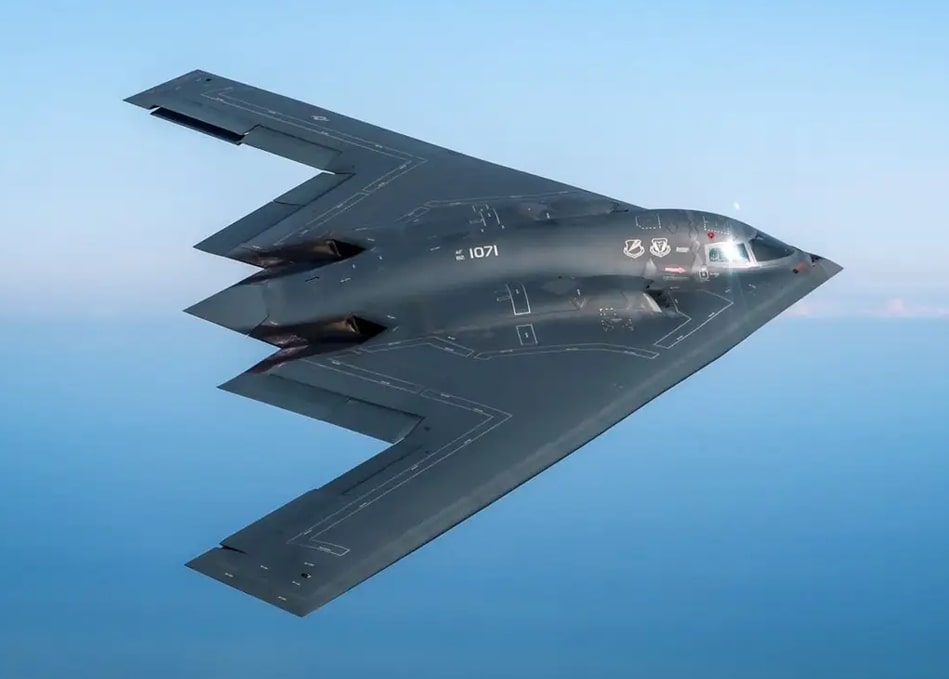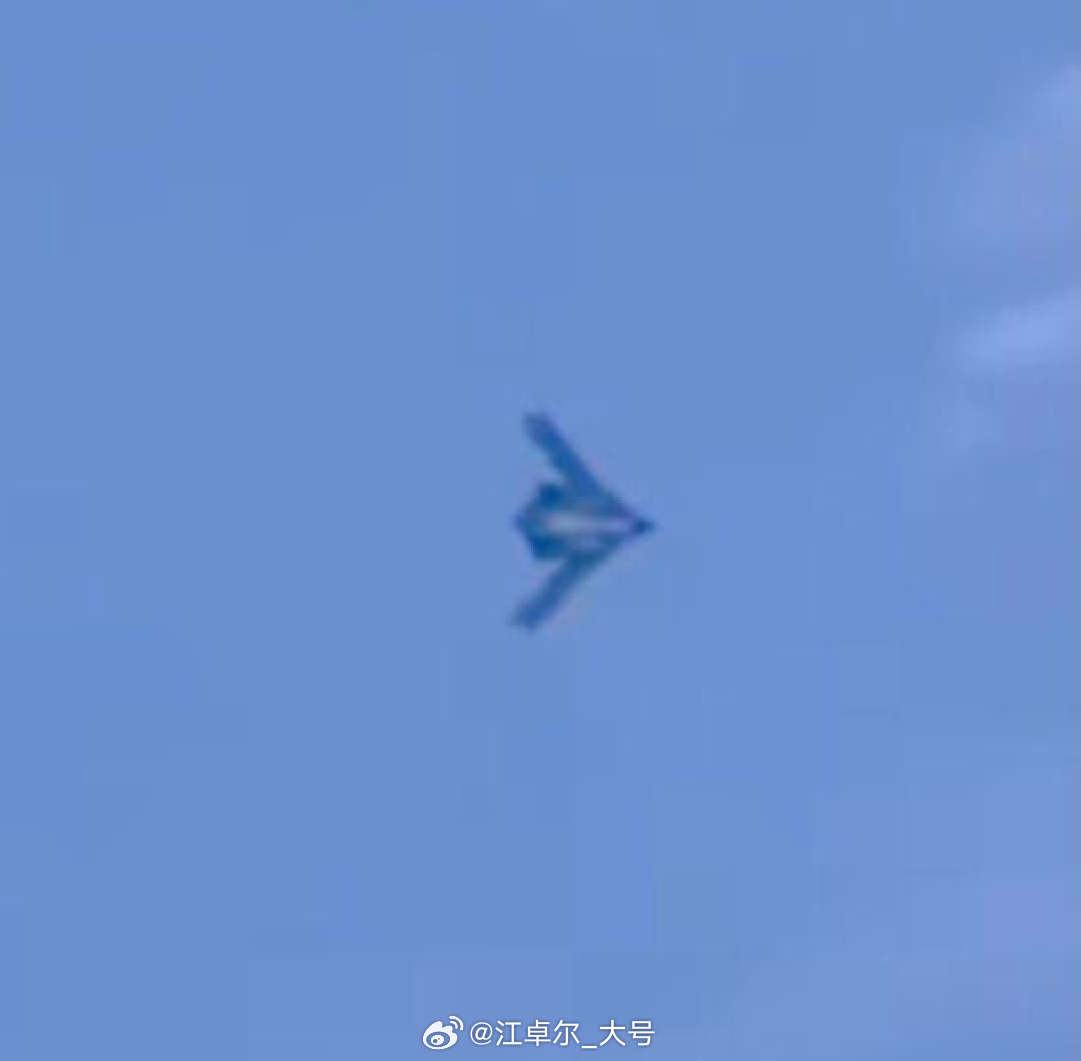From Iran Raids to Sarawak Skies: Is America’s B-2 Spirit Probing Indo-Pacific Defences ???
A single photo from rural Sarawak fuels speculation of a secretive B-2 Spirit flyover — or could China’s elusive Xian H-20 be testing Southeast Asia’s radar gaps?
A single photograph taken near a traditional longhouse in Saratok, Sarawak, has unexpectedly thrown a quiet corner of Malaysian Borneo into the centre of a geo-strategic debate, igniting speculation about whether a highly classified stealth bomber was spotted slicing through local airspace.
The image, first shared on the r/Malaysia subreddit by user Anubiroz, shows what appears to be a distinct flying-wing silhouette — one that has become synonymous with the United States Air Force’s (USAF) B-2 Spirit.
“Taken by a friend near his long house at Saratok in the afternoon… Zoom in… does it look like a kite or a stealth bomber? He said it made a swish sound… Hmmm. Looks kinda sus for a kite or a drone. Any ideas?” wrote Anubiroz, sparking a viral debate online.
Local aviation regulators were swift to respond.
The Civil Aviation Authority of Malaysia (CAAM) confirmed that no known stealth bomber flights were cleared to operate over Saratok during the time of the sighting.
CAAM CEO Datuk Captain Norazman Mahmud as quoted by local English daily, New Straits Times said, there is no record of any flight resembling a stealth bomber over Saratok, Sarawak, following viral claims of a sighting.
“However, there is drone activity in the Saratok and Pantu areas, for which a Notice to Airmen (NOTAM) was issued,” he added.

While hobby drones and kites are common sights in rural Sarawak, observers caution that dismissing the possibility of a stealth aircraft transit may overlook the region’s growing relevance in long-range bomber operations.
In the realm of modern airpower, the presence of the B-2 Spirit in Southeast Asian skies would be a calculated extension of the United States’ show-of-force strategy at a time when tensions over Iran’s nuclear ambitions have reignited covert airstrike operations.
Developed by Northrop Grumman and inducted into the USAF in 1997, the B-2 Spirit remains the world’s only operational stealth bomber specifically designed for deep penetration of heavily defended airspace.
The Spirit’s iconic flying-wing profile, constructed with radar-absorbent materials and advanced composite structures, reduces its radar cross-section to a level that makes it virtually undetectable by conventional air surveillance.
With a maximum unrefueled range of 11,000 km (6,900 miles) and the ability to carry up to 40,000 lbs (18,000 kg) of mixed conventional and nuclear ordnance, the B-2 remains a cornerstone of the United States’ nuclear triad and a potent symbol of its global strike capability.
Recent operations have once again demonstrated the B-2’s enduring strategic relevance.

Last month, a squadron of six B-2 Spirits have been tasked with conducting highly sensitive precision raids against Iran’s deeply buried uranium enrichment facilities at Fordow, Natanz, and Esfahan — sites that have long challenged conventional strike options due to their hardened underground defences.
The USAF’s calculated deployment of these stealth bombers for such complex operations sends an unmistakable signal of Washington’s determination to disrupt Tehran’s nuclear ambitions when diplomatic efforts reach an impasse.
To execute these extended-range operations, several B-2 Spirits have been forward-deployed to Diego Garcia, the remote but strategically invaluable atoll in the Indian Ocean.
This British-administered base — leased by the United States for decades — has historically served as a launch pad for operations from the Gulf War through Afghanistan, providing a secure staging area for B-52 Stratofortress, B-1B Lancer, and now B-2 Spirit missions.
If the Saratok sighting was indeed a Spirit bomber, it could signal a test run of transiting over the South China Sea and Borneo — routes that remain vital for long-range training missions, radar-mapping sorties, or simulated penetration drills designed to test the readiness of regional air defence networks in the broader Indo-Pacific theatre.
Geographically, Saratok sits within Sarawak on the island of Borneo, just a short flight from the South China Sea — one of the world’s most contested maritime corridors and a key arena for US-China military posturing.

This location places Sarawak well within the broader sphere of the Indo-Pacific’s strategic flashpoints, from the vital Malacca Strait and the Spratly Islands to the sensitive air routes that link the US base at Diego Garcia with forward operating hubs in Guam, Okinawa, and even Taiwan’s ADIZ.
Any stealth bomber transit through this airspace would not only test surveillance gaps but also signal the type of multi-axis operations the USAF might execute in the event of an Indo-Pacific contingency involving Taiwan or the wider South China Sea disputes.
However, some analysts are not convinced that the ‘mystery plane’ belongs to the USAF at all.
In recent years, Beijing has accelerated its ambitions to field a stealth strategic bomber, with the Xian H-20 poised to become the People’s Liberation Army Air Force (PLAAF) answer to America’s B-2.
Though the H-20 remains under tight wraps, leaks and satellite imagery have fuelled speculation that China’s new bomber mirrors the flying-wing design of the Spirit, promising a low radar signature, intercontinental range, and the capability to strike U.S. bases as far away as Guam and Diego Garcia.
Unverified reports hint that prototype H-20 test flights could already be taking place over the South China Sea, with Borneo’s sparse radar coverage providing an attractive corridor for validating the bomber’s stealth profile against regional surveillance networks.
If so, the appearance of such an asset over Saratok would represent a bold step in China’s quest to erode the U.S. strategic bomber advantage — and a sharp reminder that the technological arms race for regional air superiority is now very much alive above Southeast Asia’s jungles and coastlines.
Still, for every dramatic scenario involving state-of-the-art stealth bombers, there remains the mundane possibility that the object caught on camera was no more than an oddly shaped kite or a large hobby drone — both of which can appear suspiciously sleek when captured against an overexposed sky.
Yet, the broader takeaway is clear: as the Indo-Pacific theatre becomes the new epicentre for strategic bomber deployment and stealth technology rivalry, no corner of its vast airspace — not even the quiet longhouses of rural Sarawak — can be assumed free from the shadows of cutting-edge military power projection.
From Diego Garcia’s distant runway to the contested air corridors above the South China Sea, the silhouette of a flying wing remains a potent symbol of both American deterrence and Chinese ambition.
Whether Saratok’s fleeting sighting proves to be fact or fiction, its viral echo is a stark reminder that the next frontier for stealth dominance is likely to unfold right above the unsuspecting eyes of communities who once believed themselves far from the crosshairs of great power competition.
Defence Security Asia will continue to track this developing story, monitoring satellite imagery, radar data, and regional flight movements to verify whether the ‘Spirit’ truly passed over Sarawak — or whether a new ‘phantom’ has taken to the skies in the form of China’s Xian H-20.


